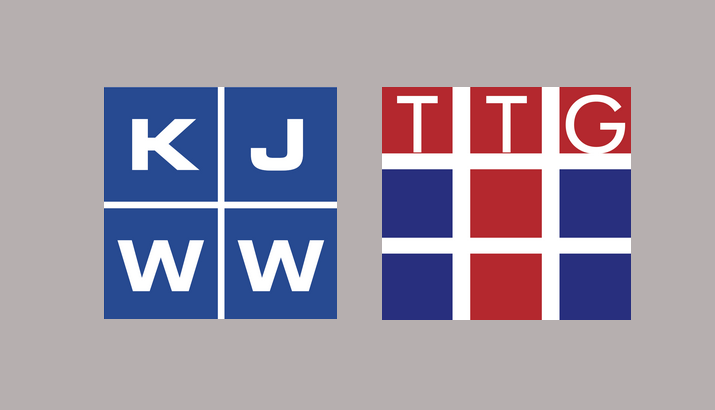Two of the nonresidential building industry’s leading engineering firms have joined forces to leverage their similar sizes and market strategies.
KJWW Engineering, based in Rock Island, Ill., and TTG Engineers, based in Pasadena, Calif., will continue to operate under their own banners, but within a newly created holding company with common management.
Ranked 11th and 14th, respectively, on BD+C’s 2014 Engineering Giants list, the firms’ combined revenues last year would have elevated them to No. 4.
The merger unites two companies with a combined 860 employees working in 25 national and five international locations. “The merger gives TTG and KJWW a larger presence throughout the U.S. and strengthens our collective dominance in the healthcare, higher education, government, entertainment, industrial, and transportation markets,” said Zareh Astrouian, PE, SE, president of TTG. Paul VanDuyne, PE, KJWW’s president, added that the merger “allows us to build on those strengths with greater geographic mobility.”
In an interview with BD+C, VanDuyne—who will be CEO of the holding company, with Astrouian its chairman— said the two firms would spend the next 15 months integrating their operational infrastructure, such as accounting, IT, etc. Over that period, the companies will keep their engineering teams intact, while integrating similar practices. VanDuyne was quick to note that the merger is not a prelude to staff reductions. “Human capital is at such a premium right now, and we would be very happy to go through this process without losing a single person.”
VanDuyne believed this merger would allow both companies to serve national end-user clients more effectively. TTG should gain from KJWW’s strengths in such areas as medical equipment planning and architectural lighting, while KJWW should benefit from TTG’s expertise in the entertainment sector. “We feel this is a great opportunity to take a look at a brand new organization. That’s a little bit extraordinary for two $50 million companies,” he said.
The firms’ executives have been discussing this merger for about a year, said VanDuyne. “It started with a phone call about getting together. We met at [KJWW’s] offices in Chicago, and it went on from there.”
KJWW and TTG announced their merger less than a month after Thornton Tomasetti merged with Weidlinger Associates. While VanDuyne didn’t think these events necessarily presaged more consolidation among engineering companies, he did note that “scale” is becoming more important for firms to be relevant to clients in such areas as BIM and sustainability.
It hasn’t been determined whether the firms would eventually operate out of a single headquarters. That seems unlikely, at least in the near future, especially when Van Duyne said “I don’t think this is the last time you’re going to hear from us about expanding across the country.”
Related Stories
| Jan 19, 2011
New Fort Hood hospital will replace aging medical center
The Army Corps of Engineers selected London-based Balfour Beatty and St. Louis-based McCarthy to provide design-build services for the Fort Hood Replacement Hospital in Texas, a $503 million, 944,000-sf complex partially funded by the American Recovery and Reinvestment Act. The firm plans to use BIM for the project, which will include outpatient clinics, an ambulance garage, a central utility plant, and three parking structures. Texas firms HKS Architects and Wingler & Sharp will participate as design partners. The project seeks LEED Gold.
| Jan 19, 2011
Museum design integrates Greek history and architecture
Construction is under way in Chicago on the National Hellenic Museum, the nation’s first museum devoted to Greek history and culture. RTKL designed the 40,000-sf limestone and glass building to include such historic references as the covered walkway of classical architecture and the natural wood accents of Byzantine monasteries. The museum will include a research library and oral history center, plus a 3,600-sf rooftop terrace featuring three gardens. The project seeks LEED Silver.
| Jan 19, 2011
Large-Scale Concrete Reconstruction Solid Thinking
Driven by both current economic conditions and sustainable building trends, Building Teams are looking more and more to retrofits and reconstruction as the most viable alternative to new construction. In that context, large-scale concrete restoration projects are playing an important role within this growing specialty.
| Jan 10, 2011
Michael J. Alter, president of The Alter Group: ‘There’s a significant pent-up demand for projects’
Michael J. Alter, president of The Alter Group, a national corporate real estate development firm headquartered in Skokie, Ill., on the growth of urban centers, project financing, and what clients are saying about sustainability.
| Jan 7, 2011
BIM on Target
By using BIM for the design of its new San Clemente, Calif., store, big-box retailer Target has been able to model the entire structural steel package, including joists, in 3D, chopping the timeline for shop drawings from as much as 10 weeks down to an ‘unheard of’ three-and-a-half weeks.
| Jan 7, 2011
How Building Teams Choose Roofing Systems
A roofing survey emailed to a representative sample of BD+C’s subscriber list revealed such key findings as: Respondents named metal (56%) and EPDM (50%) as the roofing systems they (or their firms) employed most in projects. Also, new construction and retrofits were fairly evenly split among respondents’ roofing-related projects over the last couple of years.
| Jan 7, 2011
Total construction to rise 5.1% in 2011
Total U.S. construction spending will increase 5.1% in 2011. The gain from the end of 2010 to the end of 2011 will be 10%. The biggest annual gain in 2011 will be 10% for new residential construction, far above the 2-3% gains in all other construction sectors.
| Jan 7, 2011
Mixed-Use on Steroids
Mixed-use development has been one of the few bright spots in real estate in the last few years. Successful mixed-use projects are almost always located in dense urban or suburban areas, usually close to public transportation. It’s a sign of the times that the residential component tends to be rental rather than for-sale.
| Jan 4, 2011
Product of the Week: Zinc cladding helps border crossing blend in with surroundings
Zinc panels provide natural-looking, durable cladding for an administrative building and toll canopies at the newly expanded Queenstown Plaza U.S.-Canada border crossing at the Niagara Gorge. Toronto’s Moriyama & Teshima Architects chose the zinc alloy panels for their ability to blend with the structures’ scenic surroundings, as well as for their low maintenance and sustainable qualities. The structures incorporate 14,000 sf of Rheinzink’s branded Angled Standing Seam and Reveal Panels in graphite gray.
















